Navajo Uranium Radiation Victims
(photographs © Kerry Richardson)
In September, 1990, a meeting was held at the Cove Chapter
house of the Navajo Indian Nation. In the 1940's and 1950's,
American Indians from the local community mined uranium ore
from the hills around Cove for the atomic weapons program of
the United States. Now the area is the location of a cluster of
lung cancer and other respiratory diseases related to uranium.
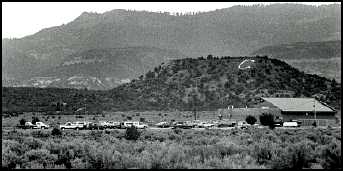
For two days inside the Chapter house the Navajo's listened to
testimony from former miners and relatives of miners who had
died. The United States Congress had just passed a law
authorizing cash payments to some of the miners or their family
members who could prove the miners had received a certain
level of exposure to radiation in the mines and who then
subsequently developed lung cancer or one of several other
respiratory diseases.
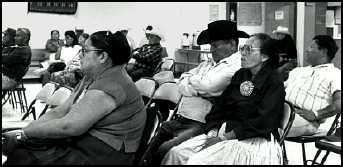
The meeting was conducted almost entirely in the Navajo
language. In addition to testimony from surviving miners, there
were also presentations by the Navajo Nation's Abandoned
Minelands Reclamation Project and also the tribe's Office of
Navajo Uranium Workers. They were attempting to deal with the
aftermath of uranium mining in the area, including identifying
hundreds of mining sites in the area, compiling a registry of all
tribal mine and mill workers, assisting with the complicated
claims process for compensation, and improving health services
for the many sick and injured people.
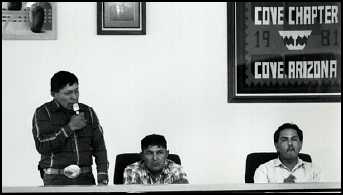
At first, it was a mystery as to why there was so much lung
disease in the community, but by now it is understood that, as
one of the widows stated, the miners, their husbands, died
because the uranium ate up their lungs.
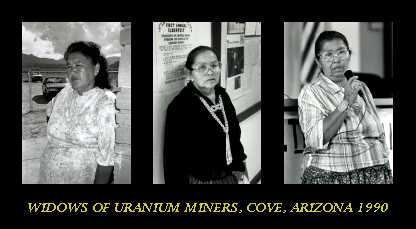
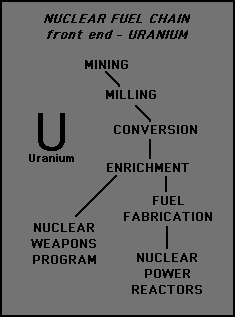
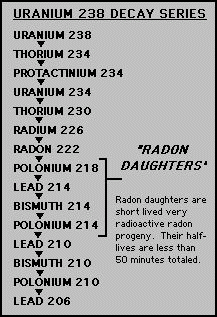

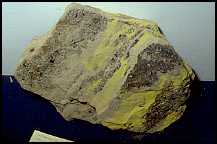
The illustrations above show the following: the front end of the
nuclear fuel chain or the travels of uranium; the radioactive
decay series of uranium 238 including the "radon daughters"; a
quote from the February-March, 1979 issue of "Mine Safety &
Health" published by the U.S. Department of Labor regarding
alpha radiation causing lung damage to uranium miners; a
uranium ore sample.
 A more thorough and up to date account of
the struggle of the Navajos to obtain some measure of relief
from the problems caused by uranium mining is contained in the
book "If You Poison Us: Uranium and Native Americans" by Peter
H. Eichstaedt, published in 1994 by Red Crane Books, 2008
Rosina Street, Suite B, Santa Fe, New Mexico, 87505. The book
is illustrated with numerous photographs of the people involved,
as well as pictures of the abandoned mine sites in the area.
Many of the surviving Navajo miners are interviewed. There is a
discussion of some shortcomings of the 1990 Radiation Exposure
Compensation Act, and an account of efforts at mine
reclamation.
A more thorough and up to date account of
the struggle of the Navajos to obtain some measure of relief
from the problems caused by uranium mining is contained in the
book "If You Poison Us: Uranium and Native Americans" by Peter
H. Eichstaedt, published in 1994 by Red Crane Books, 2008
Rosina Street, Suite B, Santa Fe, New Mexico, 87505. The book
is illustrated with numerous photographs of the people involved,
as well as pictures of the abandoned mine sites in the area.
Many of the surviving Navajo miners are interviewed. There is a
discussion of some shortcomings of the 1990 Radiation Exposure
Compensation Act, and an account of efforts at mine
reclamation.
From the introduction: "This book is the story of how uranium
mining began on Indian lands in the American West, how it was
conducted, and how its deadly legacy still lingers in the lives of
the men, women, and children whose harmony and homelands
have been destroyed."
Click for links:
A longer text report on the September 1990 meeting in Cove, Arizona organized
by the Southwest Indigenous Uranium Forum with the Navajo Uranium Radiation
Victims Committee.
"In Motion Magazine" article featuring Timothy Benally, Sr., Director of the
Office of Navajo Uranium Workers.
Back to Kerry Richardson Home Page.










 A more thorough and up to date account of
the struggle of the Navajos to obtain some measure of relief
from the problems caused by uranium mining is contained in the
book "If You Poison Us: Uranium and Native Americans" by Peter
H. Eichstaedt, published in 1994 by Red Crane Books, 2008
Rosina Street, Suite B, Santa Fe, New Mexico, 87505. The book
is illustrated with numerous photographs of the people involved,
as well as pictures of the abandoned mine sites in the area.
Many of the surviving Navajo miners are interviewed. There is a
discussion of some shortcomings of the 1990 Radiation Exposure
Compensation Act, and an account of efforts at mine
reclamation.
A more thorough and up to date account of
the struggle of the Navajos to obtain some measure of relief
from the problems caused by uranium mining is contained in the
book "If You Poison Us: Uranium and Native Americans" by Peter
H. Eichstaedt, published in 1994 by Red Crane Books, 2008
Rosina Street, Suite B, Santa Fe, New Mexico, 87505. The book
is illustrated with numerous photographs of the people involved,
as well as pictures of the abandoned mine sites in the area.
Many of the surviving Navajo miners are interviewed. There is a
discussion of some shortcomings of the 1990 Radiation Exposure
Compensation Act, and an account of efforts at mine
reclamation.